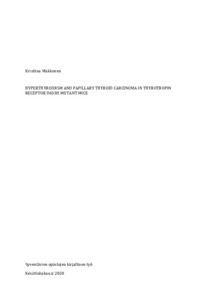Hyperthyroidism and Papillary Thyroid Carcinoma in Thyrotropin Receptor D633H Mutant Mice
Makkonen, Kristiina (2021-03-26)
Hyperthyroidism and Papillary Thyroid Carcinoma in Thyrotropin Receptor D633H Mutant Mice
Makkonen, Kristiina
(26.03.2021)
Julkaisu on tekijänoikeussäännösten alainen. Teosta voi lukea ja tulostaa henkilökohtaista käyttöä varten. Käyttö kaupallisiin tarkoituksiin on kielletty.
avoin
Julkaisun pysyvä osoite on:
https://urn.fi/URN:NBN:fi-fe2021081142820
https://urn.fi/URN:NBN:fi-fe2021081142820
Tiivistelmä
Background: Constitutively active thyrotropin receptor (TSHR) mutations are the most common etiology of non-autoimmune hyperthyroidism (NAH). Thus far, the functionality of these mutations has been tested in vitro, but the in vivo models are lacking.
Methods: To understand the pathophysiology of NAH, we introduced the patient-derived constitutively active TSHR D633H mutation into the murine Tshr by homologous recombination.
Results: In this model, we observed both subclinical and overt hyperthyroidism depending on the age, sex and copy number of the mutated allele. Homozygous mice presented hyperthyroidism at 2 months of age, while heterozygous animals showed only suppressed TSH. Interestingly, at 6 months of age, thyroid hormone concentrations in all mutant mice were analogous to wildtypes, and they showed colloid goiter with flattened thyrocytes. Strikingly, at one-year of age nearly all homozygous mice presented large papillary thyroid carcinomas (PTC). Mechanistically, this PTC phenotype was associated with an overactive thyroid and strongly increased stainings of proliferation, pERK, and NKX2-1 markers, but no mutations in the “hot-spot” areas of common oncogenes (Braf, Nras, Kras) were found.
Conclusions: this is the first study to reveal the dynamic age-, sex- and gene dosage-dependent development of NAH. Furthermore, we show that a constitutively active TSHR can trigger a malignant transformation of thyrocytes.
Methods: To understand the pathophysiology of NAH, we introduced the patient-derived constitutively active TSHR D633H mutation into the murine Tshr by homologous recombination.
Results: In this model, we observed both subclinical and overt hyperthyroidism depending on the age, sex and copy number of the mutated allele. Homozygous mice presented hyperthyroidism at 2 months of age, while heterozygous animals showed only suppressed TSH. Interestingly, at 6 months of age, thyroid hormone concentrations in all mutant mice were analogous to wildtypes, and they showed colloid goiter with flattened thyrocytes. Strikingly, at one-year of age nearly all homozygous mice presented large papillary thyroid carcinomas (PTC). Mechanistically, this PTC phenotype was associated with an overactive thyroid and strongly increased stainings of proliferation, pERK, and NKX2-1 markers, but no mutations in the “hot-spot” areas of common oncogenes (Braf, Nras, Kras) were found.
Conclusions: this is the first study to reveal the dynamic age-, sex- and gene dosage-dependent development of NAH. Furthermore, we show that a constitutively active TSHR can trigger a malignant transformation of thyrocytes.
